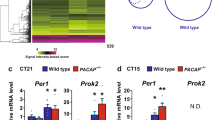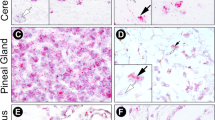Abstract
MANY substances in the rat pineal organ exhibit marked diurnal variations; some of these fluctuations are circadian, that is, cued but not driven by environmental lighting. The content of the pineal hormone melatonin1 for example, is seven- to tenfold higher during the dark phase of the diurnal cycle than during the light phase2. Similarly, the activities of the melatonin-synthesising enzymes 5-hydroxytryptarnine-N-acetyl transferase (NAT) and hydroxyindole-O-methyl transferase (HIOMT) are also higher in the dark (by factors of 15–70-fold and threefold, respectively3,4). The immediate precursor of melatonin, N-acetyl 5-HT is 10–30-fold higher in the dark than in the light5. In contrast the pineal content of the precursor of N-acetyl 5-HT, 5-HT is twofold higher in the light than in the dark phase of the diurnal cycle6, suggesting that changes in NAT activity regulate changes in melatonin biosynthesis. These changes have been shown to be controlled by environmental light acting through the retina by way of central nervous pathways to the superior cervical ganglion, and thence through postganglionic sympathetic fibres to the pineal body7. Nor-adrenaline released from these fibres acts on β adrenoceptors on the parenchymal pineal cells to stimulate adenylate cyclase, causing an increase in intracellular cyclic AMP which is followed by increased NAT activity and melatonin biosynthesis8,9. Decentralisation, superior cervical ganglionectomy, administration of β-adrenoceptor blocking drugs or protein synthesis inhibitors can all block the light–dark changes observed in NAT activity in this organ10,11.
This is a preview of subscription content, access via your institution
Access options
Subscribe to this journal
Receive 51 print issues and online access
$199.00 per year
only $3.90 per issue
Buy this article
- Purchase on Springer Link
- Instant access to full article PDF
Prices may be subject to local taxes which are calculated during checkout
Similar content being viewed by others
References
Wurtman, R. J., Axelrod, J., and Kelly, D. E., The Pineal (Academic, New York, 1968).
Quay, W. B., Proc. Soc. exp. Biol. Med., 115, 710–716 (1964).
Klein, D. C., and Weller, J. L., Science, 169, 1093–1095 (1970).
Axelrod, J., Wurtman, R. J., and Snyder, S. H., J. biol. Chem., 240, 949–954 (1965).
Klein, D. C., and Weller, J. L., Science, 177, 532–533 (1972).
Quay, W. B., Gen. comp. Endocr., 3, 473–479 (1963).
Wurtman, R. J., Axelrod, J., and Fischer, J. E., Science, 143, 1328–1330 (1964).
Weiss, B., and Costa, E., J. Pharmac. exp. Ther., 161, 310–319 (1968).
Wurtman, R. J., Shein, H. M., and Larin, F., J. Neurochem., 18, 1683–1687 (1971).
Axelrod, J., and Wurtman, R. J., Adv. Pharmac., 6, 157–166 (1968).
Klein, D. C., The Neurosciences: Third Study Volume (edit. by Parker, K. O.), 509–515 (MIT Press, Cambridge, Massachusetts, 1973).
Minneman, K. P., and Iversen, L. L., Science (in the press).
Thompson, W. J., and Appleman, M. M., Biochem., 10, 311–316 (1971).
Lynch, T. J., and Cheung, W. Y., Analyt. Biochem., 67, 130–135 (1975).
Uzunov, P., Revuelta, A., and Costa, E., Molec. Pharmac., 11, 506–510 (1975).
Oleshansky, M. A., and Neff, N. H., Molec. Pharmac., 11, 552–557 (1975).
Romero, J., and Axelrod, J., Science, 184, 1091–1093 (1974).
Kebabian, J. W., Zatz, M., Romero, J. A., and Axelrod, J., Proc. natn. Acad. Sci. U.S.A., 72, 3735–3739 (1975).
Romero, J. A., Zatz, M., Kebabian, J. W., and Axelrod, J., Nature, 258, 435–436 (1976).
Deguchi, T., and Axelrod, J., Molec. Pharmac., 6, 612–618 (1973).
Weiss, B., and Costa, E., Science, 156, 1750–1752 (1967).
Author information
Authors and Affiliations
Rights and permissions
About this article
Cite this article
MINNEMAN, K., IVERSEN, L. Diurnal rhythm in rat pineal cyclic nucleotide phosphodiesterase activity. Nature 260, 59–61 (1976). https://doi.org/10.1038/260059a0
Received:
Accepted:
Issue Date:
DOI: https://doi.org/10.1038/260059a0
This article is cited by
-
Circadian variations of adrenergic receptors in the mammalian pineal gland: A review
Journal of Neural Transmission (1990)
-
Melatonin biosynthesis in the mammalian pineal gland
Experientia (1989)
-
Interaction between ?- and ?-adrenoceptors in rat pineal adenosine cyclic 3?,5?-monophosphate phosphodiesterase activation
Journal of Neural Transmission (1985)
-
Diurnal changes in cyclic nucleotide levels in the hypothalamus of the rat
Experimental Brain Research (1980)
Comments
By submitting a comment you agree to abide by our Terms and Community Guidelines. If you find something abusive or that does not comply with our terms or guidelines please flag it as inappropriate.



